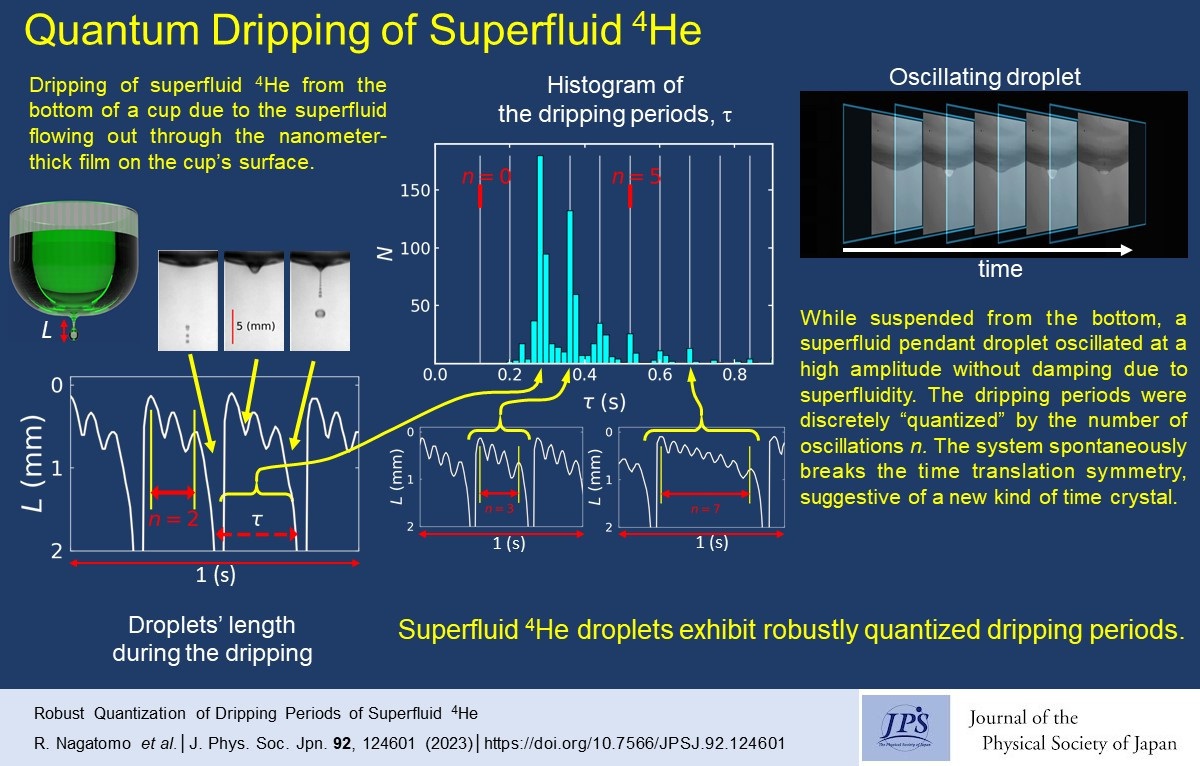Quantum Dripping of Superfluid 4He
© The Physical Society of Japan
This article is on
Robust Quantization of the Dripping Periods of Superfluid 4He
J. Phys. Soc. Jpn.
92,
124601
(2023)
.

Water dripping from faucets is a common occurrence in daily life. People have noticed that water does not drip at regular intervals, even if the flow rate remains the same. It may drip at short or long intervals with no predictable patterns. This chaotic behavior is caused by tiny droplet oscillations, which cause complex dynamics in classical fluids. Although there is considerable interest in understanding the differences between superfluid and dissipative classical flows, very little is known about their essential differences, particularly in highly nonlinear regimes. This study shows that the dripping behavior of superfluid 4He droplets is very different from that of classical droplets. The dripping periods of the superfluid droplets were quantized at discrete values, even when the input flow rates gradually varied. This is due to the high-amplitude and undamped oscillation of the droplets, which is a direct consequence of superfluidity.
To observe the dripping of the superfluid, spontaneous flow from a cup with an open top, the so-called superfluid film flow, was utilized. This has been used as a popular demonstration to demonstrate the peculiarity of a superfluid that can flow without dissipation through a nanometer-thick film formed on the cup surface. A high-speed video camera was used to capture the dripping of superfluid 4He droplets from the bottom of the cup via superfluid film flow.
When a superfluid pendant droplet is suspended from the bottom, it oscillates with a high amplitude and negligible damping. The amplitude is sufficiently high, causing it to consistently pinch off during the downward phase of the oscillation. The dripping periods of the droplets were discretized at the values specified by the number of oscillations when suspended from the bottom. This is in contrast to a water droplet, which oscillates at a small amplitude and only causes a delay or hast in the pinch-off, resulting in the chaotic behavior of classical fluids. The high-amplitude oscillation of the superfluid droplet removed the small difference and suppressed the occurrence of chaos in the dripping dynamics. The stably discretized periods indicate the spontaneous breaking of time translation symmetry, suggesting a new kind of time crystal realized in superfluid dripping; however, further investigation is needed for confirmation.
(Written by Nomura on behalf of all the authors )
Robust Quantization of the Dripping Periods of Superfluid 4He
J. Phys. Soc. Jpn.
92,
124601
(2023)
.
Share this topic
Fields
Related Articles
-
Qualitative Changes in Kinetic Pathways Driven by Hydrodynamic Interactions in Dense Colloidal Suspensions
Cross-disciplinary physics and related areas of science and technology
Statistical physics and thermodynamics
Structure and mechanical and thermal properties in condensed matter
2025-4-18
Even in dense colloidal suspensions, where long-range hydrodynamic interactions are screened, near-field hydrodynamic interactions qualitatively influence the selection of kinetic pathways.
-
Bayesian Insights into X-ray Laue Oscillations: Quantitative Surface Roughness and Noise Modeling
Measurement, instrumentation, and techniques
Structure and mechanical and thermal properties in condensed matter
2025-2-14
This study adopts Bayesian inference using the replica exchange Monte Carlo method to accurately estimate thin-film properties from X-ray Laue oscillation data, enabling quantitative analysis and appropriate noise modeling.
-
Hyperuniform and Multifractal States in Bosonic Quasicrystalline Systems
Statistical physics and thermodynamics
Structure and mechanical and thermal properties in condensed matter
2025-2-10
Quantum states can be categorized as hyperuniform or multifractal based on electronic characteristics. This study demonstrates that bosonic quasicrystalline systems exhibit hyperuniform or multifractal quantum states.
-
Spin-Spin Interaction Mediated by Rotational Lattice Vibrations
Magnetic properties in condensed matter
Structure and mechanical and thermal properties in condensed matter
2025-1-24
This study predicts the presence of spin-spin interactions mediated by the angular momentum of lattice vibrations, which can be long-range.
-
Unlocking Secrets of Novel Charge-Orbital States in Transition-Metal Compounds
Cross-disciplinary physics and related areas of science and technology
Electron states in condensed matter
Electronic structure and electrical properties of surfaces and nanostructures
Magnetic properties in condensed matter
Structure and mechanical and thermal properties in condensed matter
2025-1-6
A new Special Topics edition of the Journal of the Physical Society of Japan features articles exploring special transition-metal compounds that exhibit novel charge-orbital states.




